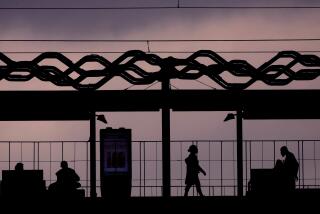Fire prevention officials don’t want sparks to fly
Santa Barbara Fire Capt. David Sadecki was on his way to an emergency call last summer when he noticed a man on a tractor mowing tinder-dry grass in a field during the hottest part of the day.
After they finished their call, Sadecki and his crew returned to confront the man.
“He was just trying to clear this field for his boss,” Sadecki recalled. “But he was doing it at the wrong time, in the heat of the day. All it would take is one spark to start a fire.”
As California enters another fire season, officials say it’s still all too common to find property owners and their employees unwittingly doing the right thing in the wrong way.
More than 1,600 fires are started each year by people improperly using mowers, weed trimmers, tractors and other power equipment to clear vegetation. Improper use of power equipment -- working without spark arresters, for example, or trimming or cutting during the hot afternoon hours -- is the single largest factor in accidentally set blazes, according to the California Department of Forestry and Fire Protection.
Most are quickly extinguished. But a few grow into roaring wildfires that destroy homes, tax the state’s firefighting capacity and cost taxpayers tens of millions of dollars to battle.
In May, flames from the Jesusita wildfire in Santa Barbara roared across mountaintops for nearly a week, destroying 80 homes and injuring 32 firefighters. Authorities believe the blaze, which cost an estimated $20 million to fight, was sparked in the early afternoon of May 5 by someone using power equipment to clear brush on a hiking trail.
It’s a problem born in part of state laws requiring property owners to clear dead vegetation from open fields and to create a 100-foot buffer around homes in advance of fire season, said Daniel Berlant, a spokesman for the state forestry department. People trying to meet that mandate often don’t take proper precautions when using brush-clearing machinery, Berlant said.
“We preach all year round about creating defensible space and clearing brush before wildfires start,” he said. “What we see often is homeowners doing it at the wrong time.”
Yard maintenance should always be done before 10 a.m. or after 6 p.m., when temperatures are lower and humidity is higher, fire officials say. In wilderness areas, spark arresters are required on gasoline-powered machines, including tractors, harvesters, chain saws and trimmers.
Metal blades striking a hard object can start a fire, so visible rocks should be removed. Officials advise carrying water to douse sparks and to use spark shields on trimmers and mowers.
The forestry department promotes the safety message each spring with public service announcements on radio and television, Berlant said. Fire prevention specialists talk to homeowners at fairs, festivals and home and garden shows to underscore the importance of being responsible with power equipment.
The agency distributes a brochure titled “Doing the Right Thing the Wrong Way” whenever its staffers meet with the public, he said. Over the last five years, the state has spent an average of $26 million annually on fire prevention, which includes public education campaigns, said Janet Upland, a deputy director with the department.
That figure could dip significantly in coming months as the state deals with a budget shortfall of up to $24 billion, said department Chief Del Walters.
Walters is proposing a fire prevention budget of $21.8 million for the 2009-10 fiscal year, a drop of nearly 30% from the current year’s $30.9 million. Walters downplayed the reduction, saying it is preliminary and that its chief effect would be on the number of fire marshals assigned to the prevention unit, not on public education efforts.
“Certainly, if there is any area in my budget that I’d like to reinforce, it would be prevention,” Walters said. “We’ll have to look closely at where our cuts will come from.”
Santa Barbara County prosecutor Jerry Lulejian doesn’t think it’s a matter of creating new laws. There are plenty on the books that strike a balance between activities likely to start a fire and people’s responsibility for those activities, said Lulejian, who has prosecuted several cases involving blazes set by accident.
But people are either ignorant of the law or don’t understand that their activities could ignite a fire, he said.
That was the case with a couple of ranch workers who accidentally started the Zaca wildfire in 2007, one of the largest in state history. On July 4, foreman Jose Cabrera and Santiago Cervantes were using grinding tools to repair a watering trough when a spark flew at least 10 feet, igniting the blaze.
It burned for nearly two months, consuming almost 375 square miles of wilderness and costing an estimated $118 million to fight.
The pair were unaware that they needed a hot-work permit. Cabrera pleaded guilty to a single misdemeanor count of negligence for using the grinder. Along with the ranch’s owners, Cabrera also agreed to create a video cautioning property owners about how to safely use power tools in dry areas, Lulejian said.
“If people took their obligations seriously, there would be no civil or criminal charges for what happens on their property,” he said.
--
catherine.saillant @latimes.com
More to Read
Sign up for Essential California
The most important California stories and recommendations in your inbox every morning.
You may occasionally receive promotional content from the Los Angeles Times.











